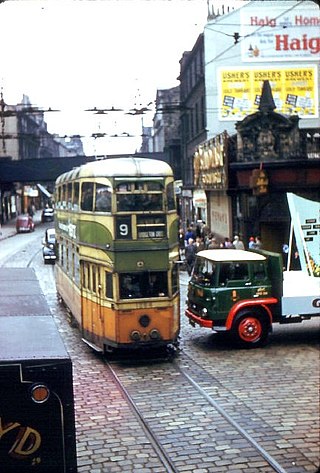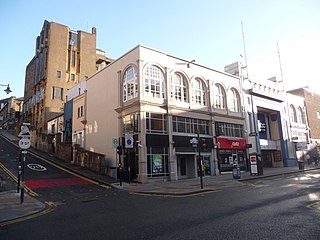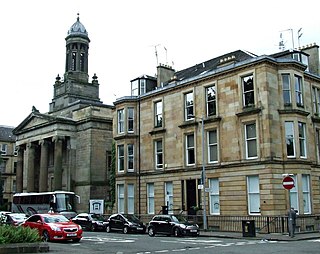
Locarno Ballrooms were a series of large public ballrooms located in England and Scotland and were represented in most major British cities.

Locarno Ballrooms were a series of large public ballrooms located in England and Scotland and were represented in most major British cities.
The company was created in 1926 and named after the Locarno treaties of 1925 which offered a new hope and spirit in post-war Europe (created in Locarno in Switzerland). Given the company's development pattern it was presumably Scots-owned. [1]
Many earlier buildings were adaptations of cinemas, which despite the growing success of cinemas were generally over-provided. The demand in these pre-sound days was for smaller and more widely distributed cinemas and some of the bigger venues struggled. The smaller cinemas were in turn hit by the advent of sound films, and many did not survive this expensive transition. [2]
The first Locarno was created in 1926 on Sauchiehall Street in Glasgow, in the shell of the Charing Cross Electric Cinema, Glasgow's first purpose built cinema. [3] This was designed by Robert Duncan in 1898 with a cast iron structure but with a traditional stone frontage with high numbers of large windows (certainly more glazing than a typical cinema of the day). [4] The original full title was the "Locarno Palais de Dance". [5] Functionally the buildings focussed on what would now be called ballroom dancing and the locations provided both professional displays plus instruction classes. The Glasgow venue was home to Scotland's first Scottish Professional Dancing Championships in 1928. [6]
The chain and brand name was mainly acquired by Mecca Leisure Group in the mid 1960s but they retained the much-loved name Locarno in most locations. Under Mecca many also gained a function as a performance venue. Several venues were particularly associated with Northern Soul.
Sadly most venues were closed prior to the revival of ballroom dancing in the UK with the beginning of Strictly Come Dancing in 2004, which potentially could have breathed new life into the venues. The main presenter Len Goodman learnt his craft in the Streatham Locarno. [7]
The first Locarno, that on Sauchiehall Street in Glasgow, still exists: both in its external form and as the main auditorium of The Garage, Glasgow, Scotland's biggest nightclub. [8] The building is a category B listed building due to its architectural and cultural significance (LB33197). [9]
In 1966, American R&B duo Ike & Tina Turner performed at the Locarno Ballroom in Coventry. [11]
Several Locarnos were the siting of "Come Dancing" in the 1960s and 70s.
The Coventry band The Specials refer to their local Locarno in their hit "Friday Night and Saturday Morning" (also covered by the French band Nouvelle Vague).
In Dundee, the site of the Locarno is remembered with the street named Locarno Close.

The Barrowland Ballroom is an entertainment venue, dance hall and music venue located in the Calton district in Glasgow, Scotland.
Blythswood Hill, centred on Blythswood Square, is an area of central Glasgow, Scotland. It extends from the west edge of Buchanan Street to Gordon Street and Bothwell Street, Charing Cross, Sauchiehall Street and Garnethill. Developed from 1800 onwards, its Georgian and Victorian architecture is a Conservation Area. It started as the "Magnificent New Town of Blythswood", becoming a part of the city-centre's business and social life.

Charing Cross (Glasgow) is a railway station close to the centre of Glasgow, Scotland, serving the district of the same name. It is managed by ScotRail and is served by trains on the North Clyde Line.

Sauchiehall Street is one of the main shopping streets in the city centre of Glasgow, Scotland, along with Buchanan Street and Argyle Street.

The Willow Tearooms are tearooms at 217 Sauchiehall Street, Glasgow, Scotland, designed by internationally renowned architect Charles Rennie Mackintosh, which opened for business in October 1903. They quickly gained enormous popularity, and are the most famous of the many Glasgow tearooms that opened in the late 19th and early 20th century. The building was fully restored, largely to Mackintosh's original designs, between 2014 and 2018. It was re-opened as working tearooms in July 2018 and trades under the name "Mackintosh at The Willow". This follows a trademark dispute with the former operator of The Willow Tearooms which was resolved in 2017. This name is now used at tearoom premises in Buchanan Street and was additionally used at the Watt Brothers Department Store in Sauchiehall Street, Glasgow between 2016 and its closure in 2019.

The O2 Academy Bristol is a music venue located on Frogmore Street in Bristol, England. It is run by the Academy Music Group. On 1 January 2009 sponsorship was taken over from Carling by telecommunications company O2 and the venue's name changed from the Carling Academy to the O2 Academy. The academy which hosts club nights and gigs was opened in 2001, and was the third Academy venue in the UK.

The Garage is a music venue and nightclub located at 490 Sauchiehall Street in Glasgow, Scotland. The club was founded by Donald C MacLeod, a veteran within Scotland's live music scene. It is Scotland's largest nightclub, opening its doors in 1994. The main hall was the first Locarno ballroom in the UK, although it has since been remodelled by the addition of an extension to the mezzanine level.

Charing Cross is a major road junction and area within the centre of Glasgow, Scotland. It is situated north of the River Clyde at the intersection of Sauchiehall Street, St George's Road, Woodlands Road, North Street and Newton Street, as well as being at a major interchange of the M8 motorway. Charing Cross marks the notional boundary between the City Centre and the West End of the city.

The Liverpool Olympia is a venue in Liverpool, England, situated on West Derby Road next to The Grafton Ballroom.
Bridge to Nowhere is a nickname used to refer to various unfinished structures around the M8 motorway in the centre of Glasgow, Scotland. They were built in the 1960s as part of the Glasgow Inner Ring Road project but left incomplete for several years. One "bridge", at Charing Cross, was completed in the 1990s as an office block. The Anderston Footbridge, a pedestrian bridge south of St Patrick's church, was finally completed in 2013 as part of a walking and cycling route.
The Apollo was a music venue at 126 Renfield Street in Glasgow city centre, Scotland. The Apollo operated from 5 September 1973 until closure on 16 June 1985 and was Glasgow's leading music venue during this period. The Apollo was a re-brand of the previous Green's Playhouse in the same building.

Glasgow Corporation Tramways were formerly one of the largest urban tramway systems in Europe. Over 1000 municipally-owned trams served the city of Glasgow, Scotland, with over 100 route miles by 1922. The system closed in 1962 and was the last city tramway in Great Britain.
Green's Playhouse was an entertainment complex comprising a cinema, ballroom, tea rooms and other facilities. The Playhouse was at 126 Renfield Street, Glasgow, Scotland, commissioned by George Green Ltd, designed by the architect John Fairweather, and built by the Cinema Building Company. Opened in 1927, the Playhouse operated until the 1970s, a decline in audience numbers in the 1960s necessitated diversification as a music venue until closure in 1973. The building continued in use as the Apollo, after being acquired by Unicorn Leisure on a lease-holding arrangement, until final closure in 1985, with subsequent demolition in 1987.

Mecca Leisure Group was a British business that ran nightclubs, hotels, theme parks, bingo parlours and Hard Rock Cafes. During the 1960s, Mecca was a centre of entertainment with numerous nightclubs throughout major United Kingdom towns and cities. Mecca ballrooms were used for the BBC TV show Come Dancing. Eric Morley was a general manager of dancing at Mecca Leisure Group and was involved in the Miss World competitions.

St Andrew House is a mid-rise skyscraper in the centre of Glasgow, Scotland.

The O2 ABC was a nightclub and music venue on Sauchiehall Street, in the centre of Glasgow. The building was constructed in 1875, renovated many times in its lifetime and also largely rebuilt in the 1920s. The building was used for numerous functions before being finally converted to its final purpose between 2002 and 2005, before finally closing in June 2018 after extensive fire damage. In 2009, the Academy Music Group took a majority stake in the venue, rebranding it the O2 ABC. The venue is protected as a category C(S) listed building. In March 2009; the Academy Music Group became the major stockholder of the O2 ABC.

Kelvingrove is a neighbourhood in the city of Glasgow, Scotland. It is situated north of the River Clyde in the West End of the city, and directly borders Kelvingrove Park to the north and the grounds of the Kelvingrove Art Gallery and Museum to the west. Its other boundaries are not precisely defined, but roughly correspond to Sauchiehall Street to the south opposite the Sandyford neighbourhood, and the Charing Cross area to the east.

Sandyford is an area of Glasgow, Scotland. It is north of the River Clyde and forms part of the western periphery of the city centre. Formerly the name of a ward under Glasgow Town Council in the first part of the 20th century, it is within a continuous area of fairly dense urban development bordering several other neighbourhoods whose mutual boundaries have blurred over time, and is possibly less well known than all of the places which adjoin it, particularly Anderston and Finnieston.

George James Miller (1902–1940) was a Scottish architect, specialising in hospitals.